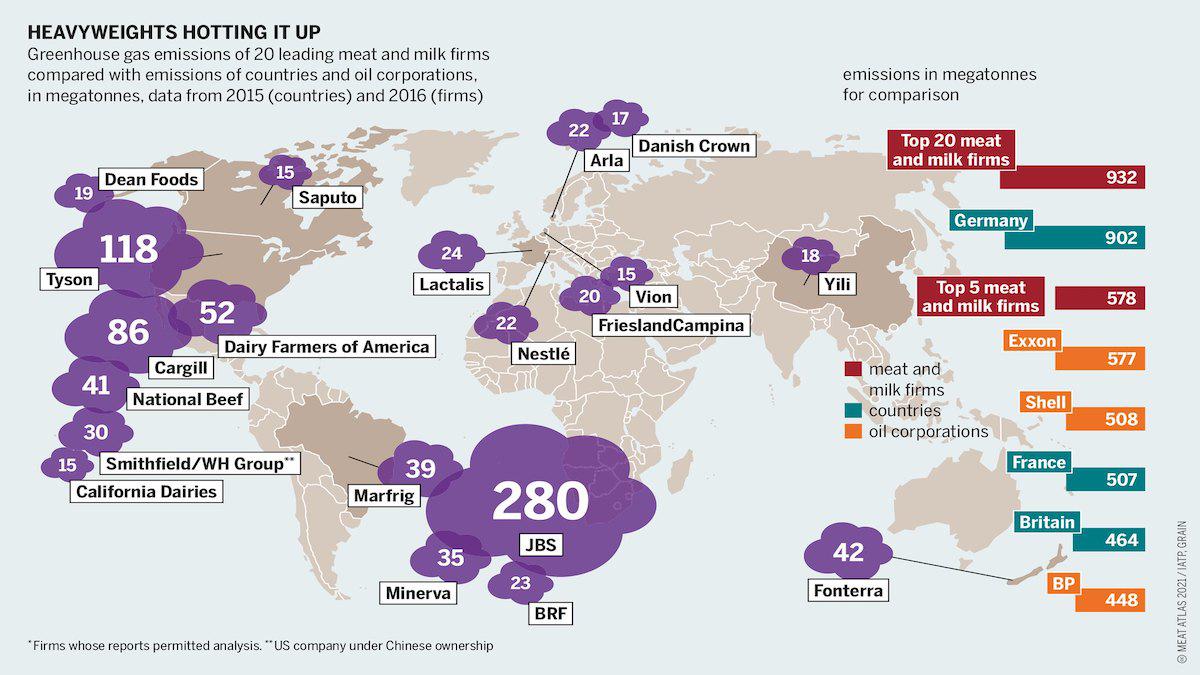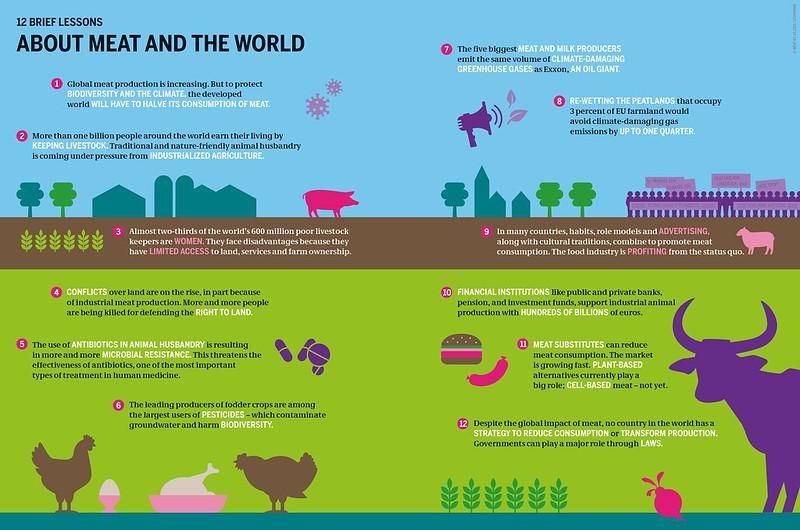
Top 5 Meat and Dairy Companies Match Exxon in Greenhouse Gas Emissions

A Meat Atlas 2021 graphic shows greenhouse gas emissions of leading meat and milk firms. Bartz / Stockmar / CC-BY 4.0
The world’s five biggest meat and dairy companies emit the same volume of greenhouse gases as fossil fuel giant ExxonMobil.
That’s just one of many shocking figures from the Meat Atlas 2021, a comprehensive look at the meat industry released by European nonprofits the Heinrich-Böll-Stiftung, Friends of the Earth Europe and BUND Tuesday.
“Europeans today eat an average of 66 kilograms (approximately 146 pounds) of meat per year per capita, which is almost twice as much as the World Health Organization actually recommends, and this persistently high consumption and production also comes with immense social and ecological costs,” Lisa Tostado, head of the International Climate, Trade & Agriculture Policy Programme for Heinrich-Böll-Stiftung, said at a public launch event. “And to raise awareness, provide information, and also foster a nuanced debate on the livestock center, the Heinrich-Böll Foundation and Friends of the Earth have compiled facts and figures on meat.”
Launch of the Meat Atlas 2021: Facts and figures about the animals we eat
www.youtube.com
Listen to the Science
The Meat Atlas 2021 is a comprehensive account of the industry’s impact on environmental and public health, totaling more than 70 pages and covering more than 30 topics from land use to greenhouse gas emissions to pesticides. These impacts include:
- Climate Change: The food and farming sector in industrialized countries accounts for about a third of global greenhouse gas emissions. The livestock sector alone is responsible for 14.5 percent of global emissions: 45 percent of that from feed production and processing, 39 percent from methane release from ruminants and 10 percent from the storage and management of manure. In fact, 20 top livestock companies together emit more than Germany, the UK or France.
- Land Use Change: Meat and milk require more land than any other consumer product, and 77 percent of agricultural land is used for either livestock or livestock feed. This means that the expansion of livestock agriculture is a major driver of land conflicts that displace Indigenous and traditional communities. The conversion of land into cattle pasture drives at least two-thirds of deforestation in the Amazon region, for example.
- Public Health: The coronavirus pandemic has drawn attention to the dangers of zoonotic diseases, diseases that pass from animals to humans. Almost 75 percent of these diseases can be traced to wildlife, and the land grabs of the meat and dairy industry increase the chance that humans will encounter new zoonotic diseases as habitat is destroyed. The rampant use of antibiotics in agriculture also increases the risks that bacteria will evolve to resist these drugs. Already, drug-resistant bacteria kill 700,000 people a year, yet 73 percent of the antibiotics used worldwide are used on animals.
Despite these and many other consequences, both meat consumption and meat production are on the rise. Meat consumption has more than doubled in 20 years, and is expected to rise another 13 percent by 2028. Meat production has also been trending upwards. In the 1970s, it stood at one third of current levels, though it declined slightly in 2019 because of an outbreak of African swine fever.
The increase in production has been enabled by many of the things that make that production so problematic: more and more animals are kept in feedlots instead of pastures. This requires their feed to be grown somewhere else, gobbling up more land. Further, such crowding is only possible with antibiotics to prevent infections from spreading in close quarters.
With all of this evidence, the report argued that reducing meat consumption in industrial countries is a case of “listening to the science,” something world governments have yet to do seriously with regards to this issue.
“We are talking not about a lack of information, and politicians not acting because they don’t know,” the atlas’ chief executive editor and head of the International Agricultural Policy Division at Heinrich-Böll-Stiftung Dr. Christine Chemnitz said at the launch. “We are talking about a lack of political will to steer or transition the agricultural sector into a climate-friendly and biodiversity-friendly direction.”
A Meat Atlas 2021 graphic summarizes meat’s impact on the world. Bartz / Stockmar / CC BY 4.0
Race to the Bottom
One clear indication we are headed in the wrong direction, Chemnitz noted, is the sheer numbers of animals slaughtered: 75 billion a year as of 2019.
But this death translates directly into profits for the largest meat and dairy companies, Shefali Sharma, one of the report authors and director of the Institute for Agriculture and Trade Policy (IATP) European office, said at the launch.
Sharma explained that the top companies are so powerful that they can set the prices they pay to producers at below the cost of production, and governments will either directly or indirectly subsidize the difference.
This creates a “race to the bottom of cheap prices, more animals, more production, more profits,” she said.
However, there is a way up and out. Sharma recommended a three-prong strategy of:
- Redirecting resources away from industrial agriculture and towards more regenerative approaches.
- Regulating companies and holding them responsible for the emissions generated by their supply chains.
- Regenerating by shifting to agroecology.
Agroecology means growing food in ways that respects natural limits while incorporating local and traditional knowledge, Stanka Becheva, a report contributor and Food and Agriculture Campaigner at Friends of the Earth Europe, explained during the launch.
“It’s really the only transformative framework which will help move the industrial… farming sector away from the concentration and the devastating impacts it has,” she said.
She also called for a ban on factory farming; turning to more diversified mixed plant and animal farming solutions; ensuring fair prices for small-scale, sustainable farmers; and changing diets to emphasize fresh, local, plant-based food.
A Strong Statement
One hopeful indicator cited by the report is the shifting attitudes of young people. The atlas highlighted a representative survey conducted by the University of Göttingen in Germany of young adults between 15 and 29 years old. It found that nearly 13 percent of them were either vegan or vegetarian, more than double the percentage of the overall German population. A further approximately 25 percent considered themselves flexitarians and only ate meat every so often.
But what was especially striking to Chemnitz was the motivation behind these decisions.
“One thing young people made really clear is that they see their reduced meat consumption as a political statement,” she said.
Their decision was not based on taste or health, but opposition to how the current meat industry operates.
The survey found that 75 percent of the vegan and nearly 50 percent of the vegetarian respondents saw themselves as part of the climate movement. Moreover, young people were in favor of government policies directed at creating a more sustainable food system. More than 70 percent of them thought the German government should encourage people to eat a climate-friendly diet and make sure food is produced in an environmentally friendly way.
“This is a strong statement,” Chemnitz said, “and it’s a strong call for our government to get active.”
- It's Time to Rethink What We Eat, Annual Meat Consumption Report ...
- The future of food: Can you eat to save the climate? | World ...
- Is China Going Vegan? Plant-Based Foods on the Rise in the ...
- New Study Links Meat Consumption to Numerous Health Risks ...
- Can We Enjoy Meat and Seafood and Save the Planet? - EcoWatch
- Animal Agriculture Responsible for 57% of Greenhouse Gas Emissions From Food Production, Study Finds

 233k
233k  41k
41k  Subscribe
Subscribe 
